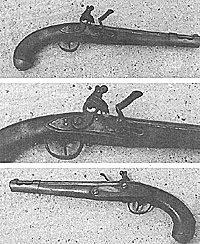
Prompted by John Grehan's note, I recently visited the Royal Artillery Museum in the Rotunda, Woolwich, London. Their Austrian pistol is an example of the 1798 Pattern cavalry pistol, the standard weapon used throughout most of the Wars.
At the start of the Revolutionary Wars, the main pattern of cavalry pistol in service was the 1770 pattern, which underwen only small stylistic changes across the next 28 years. It remained a 1 1/2 Wiener Loeth calibre weapon (actually a ball weight, but equating to 18.8mm), weighing 1470g with a barrel length of 281mm and iron mountings. the only other pistol was the 1772 pattern Miner's pistol, which was also used by the artillery (having been developed from an older Cavalry pistol). Infantry officers had been allowed to carry pistols since 1766, but like the Grenz Seressaner scouts (see Age of Napoleon 13) they were not obliged to use an official pattern.
After defeat in the War of the First Coalition, the Austrian government decided on a complete overhaul of the army, most of whose uniforms and equipment dated back to the late 1760s, just post-seven years War. A commission was established under FML (Lt.-Field Marshal) Freiherr von Unterburger, which resulted in the most familiar Austrian soldiers of the period. The firing weaponry of the mounted troops was reduced to just long and short carbines alongside the new pattern pistol.
Although most of the new Unterberger weaponry was based on French designs, the new 1798 cavalry pistol was developed from tests and adjustments to 50 pairs of Prussian pistols purchased in Potsdam in 1781. Fashioned in walnut with brass mountings, this pistol represented a change in style to a more curved handle than previously, making for a more comfortable grip and a smaller brass base to the butt. a single barrel grip at the mouth of the barrel comprised two barrel rings joined together with a sight at the end, mirroring the design of the 1798 short carbine used by the light cavalry, (Hussars, Chevaulegers and Uhlans). The weapon continued the previous Austrian practice of not having an integral iron ramrod in the shaft, but instead carrying it on the topside of the cartridge box lid.
1798 also saw two general changes across almost all weaponry. The calibre was reduced from 1 1/2 to 1 Wiener Loeth, (17.6mm), whilst a uniform larger lock mechanism was introduced, which had a sturdier frizzen and heart-shaped hammer support. A larger rounded powder pan was also made of brass.
The barrel, slightly shorter at 263mm was rounded on the outside, unlike the previous octagonal shape, and fired a ball weighing 1.39 Loeth, (24.5g). The curved handle and shorter barrel reduced overall length to 427mm. The initial pattern included a convex-shaped hammer mechanism and lockplate, but some versions were flat. With a thinner shaft, this version reduced the weapon weight further from the original 1320g to 1150g.
Troopers and junior officers were armed with a pair of pistols carried in black leather holsters at the front of the saddle. The larger shabraques, (saddle cloths) also introduced in 1798 covered the holsters almost completely, obviating the need for the holster caps used by all cavalry except the Hussars, although these were still in use as late as 1805 while the new equipment was being introduced. on dismounted duties, a single pistol was carried by troopers on a loop to the left of the waistbelt buckle.
When introduced in 1798, each pistol cost 5 florins and 40 kreuzer. The design was so successful that other than the change to percussion locks in 1844, it remained essentially unaltered until 1860. The 1798 pistol was the only pattern introduced into service with the Imperial Army during the Napoleonic era, other than the mandatory 1809 pattern infantry officer's pistol. The example in the Royal Artillery Museum is of the flat lock version and carried the maker's mark 'MA! 1155', a product of the Materna Company in Krems, (40 miles west of Vienna). It compares favourably with the collection of the shorter, buker French pistols in the same display cabinet, which were more crudely fashioned.
Acknowledgements:
The photos are by kind permission of the Curator, Mr. S. Walters, and the Trustees of the Royal Artillery Museum in Woolwich. Permission to use them where the writer makes no financial gain was granted for a reasonable donation and a copy of the ensuing article. This is a refreshing change from the many Museums whose copyright fees make it impractical to use pictures to back articles. please support the RAM and other institutions prepared to help enthusiasts. The RAM also has a number of French pistols and carbines from our period which are well worth examining.
Sources
Dolleczek: Monographie der k.u.k. oesterr-ung. blanken und Handfeuerwaffen (1896, rep. 1970).
Krenn: Die Handfeurwaffen des oesterreichischen Soldaten (Graz Exhibition catalogue) (1985).
Gli Ultimi Soldati del Sacro Romano Impero: 1987 reprint of Kininger prints originally published by Trancluillo Mollo and Mansfeld.
Back to Napoleonic Notes and Queries # 16 Table of Contents
Back to Age of Napoleon List of Issues
Back to MagWeb Master List of Magazines
© Copyright 1995 by Partizan Press.
This article appears in MagWeb (Magazine Web) on the Internet World Wide Web.
Other articles from military history and related magazines are available at http://www.magweb.com